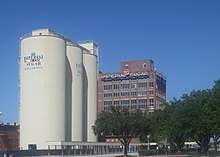Imperial Sugar
Imperial Sugar is a major U.S. sugar producer and marketer based in Sugar Land, Texas, with sugar refinery operations in California, Georgia, and Louisiana. The company was established in 1843 and has undergone ownership changes multiple times. The current name, Imperial Sugar Company, was established after a change in ownership in 1907. The company went through major expansion through acquisitions beginning in 1988, but filed for bankruptcy in 2001, emerging in the same year and embarking on a downsizing strategy. As of May 2012, the company was in the process of being purchased once more and converted from a public to a private company by Louis Dreyfus Group of the Netherlands.
 | |
| Subsidiary | |
| Industry | Food industry |
| Founded | 1843 |
| Founder | Samuel May Williams |
| Headquarters | , United States |
| Products | Sugar |
| Revenue | US$848,000,000 (2011) |
| (US$50,200,000) (2011) | |
| (US$53,400,000) (2011) | |
| Total assets | US$490,000,000 (2011) |
| Parent | Louis Dreyfus |
| Website | www |


History
The company has, since its inception, been headquartered in Sugar Land; the city itself is named for the company and the company's crown logo is featured in the city's seal. The company was founded in 1843 by Samuel May Williams and passed through a series of owners until its purchase in 1907 by the I. H. Kempner family of Galveston. The company was later renamed the Imperial Sugar Company, in an effort to emphasize quality.[2] Up until 1988 the company had only one plant, at its original location in Texas, when they purchased the Holly Sugar Corporation, a sugar beet processor headquartered in Colorado Springs. At that time Imperial Sugar Company became Imperial Holly Corporation and began publicly trading on Nasdaq.[3]
Since that initial acquisition the company has made several more acquisitions which effectively doubled the corporation's size each time. The company's name returned to Imperial Sugar Company in 1999.[3]
On January 17, 2001, the company filed Chapter 11 bankruptcy protection, attributing its problems to lower sales for refined sugar as well as higher energy costs. Then on August 29, 2001, the company emerged from Chapter 11 and has since turned its focus inward as it downsizes its operations. In 2003, Imperial won the Wharton Infosys Business Transformation Award for their innovative use of web technology to help turn around their business. The company no longer refines sugar at its original plant in Sugar Land (the facility was closed in 2003) but their corporate headquarters are still located in its founding city.
On December 19, 2010, two buildings of the Sugar Land factory were demolished by explosion to spread the development of the property for residences, business properties and park land.[4][5]
In 2010, Imperial contributed its aging nineteenth-century Gramercy, Louisiana refinery to Louisiana Sugar Refiners, LLC (LSR) in exchange for a one-third interest in the new company.[6] LSR commenced operations on January 1, 2011. LSR now operates a state-of-the-art sugar refinery on the Gramercy, Louisiana site. Imperial will continue to operate a small-bag processing facility at Gramercy.[7]
2008 explosion
On February 7, 2008, an explosion—likely caused by an overheated bearing on a conveyor beneath the sugar silos, which ignited sugar dust, then spread in a chain reaction of sugar dust explosions in the finished sugar packaging area of the plant—at a Port Wentworth, Georgia, Imperial Sugar refinery killed 14 people and injured over 40. OSHA had been criticized in a 2006 US Chemical Safety Board report for lack of preparation for such explosions and a safety program which "inadequately addresses dust explosion hazards".[8][9]
The plant, originally built as the Dixie Crystals sugar refinery in 1916–1917, was acquired by Imperial Sugar in 1997. At the time of its purchase, the Port Wentworth refinery was the second-largest sugar refining operation in the U.S.[10] As of August 26, 2008, the death toll had risen to 14, with one still in critical condition.[11]
Acquisition by Louis Dreyfus Group
On 1 May 2012, Louis Dreyfus Commodities LLC announced that one of its subsidiaries would acquire all outstanding Imperial Sugar stock for $6.35 per share and assume $125 million in Imperial Sugar debt. The price per share represented a 57% premium over Imperial Sugar's closing price on 30 April. A spokesman for Dreyfus group said the acquisition was part of the company's efforts to expand into refining and distribution of sugar.[12][13]
Gallery
- Imperial Sugar offices in Sugar Land
- Imperial Sugar Technology Center in Sugar Land
References
- "Convict Leasing and State Account Farming (1883-1909)." Texas State Library and Archives. Retrieved on April 29, 2011.
- A.C. Greene (1998). Sketches from the Five States of Texas. College Station: Texas A&M University Press. ISBN 0-89096-842-X.
- "Imperial Sugar Company History". FundingUniverse. Retrieved June 15, 2017.
- Houston Chronicle
- Fort Bend Star Plans for development.
- Louisiana Sugar Refining facility touted as 'an important project for the state'. Times-Picayune, Wednesday, February 3, 2010.
- Louisiana Sugar Refiners, LLC.
- Bynum, Russ. "At least 8 dead in blast at sugar plant". Seattle Times 9 February 2008. Retrieved on 9 February 2008.
- http://www.ajc.com/metro/content/metro/stories/2008/02/24/RefineryBlast_N0406.html
- Imperial Sugar Website
- https://news.yahoo.com/s/ap/20080224/ap_on_re_us/refinery_blast;_ylt=AuK1s0YeJOlkPSBv7knUTJGs0NUE
- Koyitty, Bijoy. "Louis Dreyfus to take Imperial Sugar private in $78 million deal". Reuters US. Thomson Reuters. Retrieved April 25, 2014.
- Kaplan, David (May 1, 2012). "Imperial Sugar acquired by private company". Houston Chronicle. Retrieved April 25, 2014.